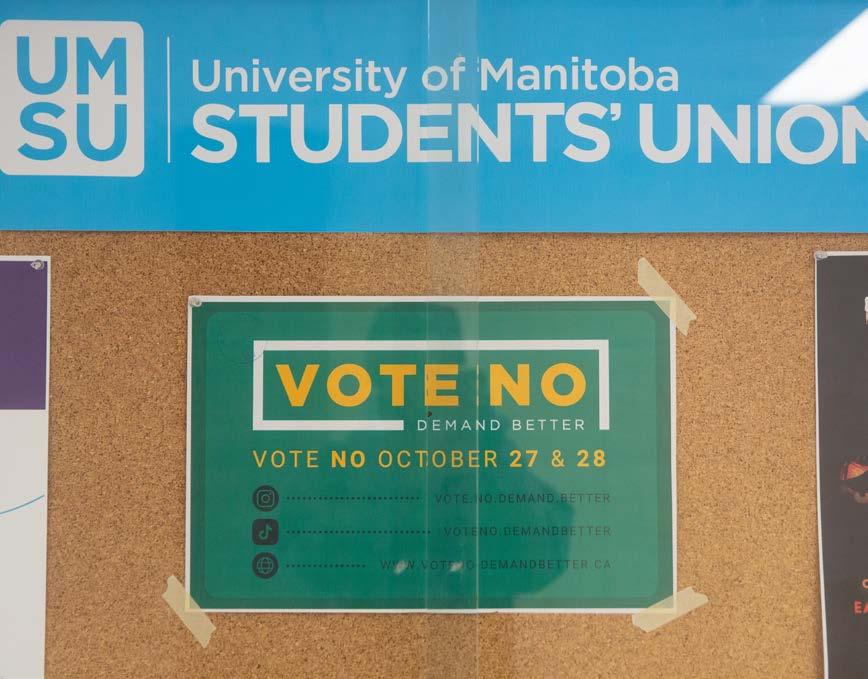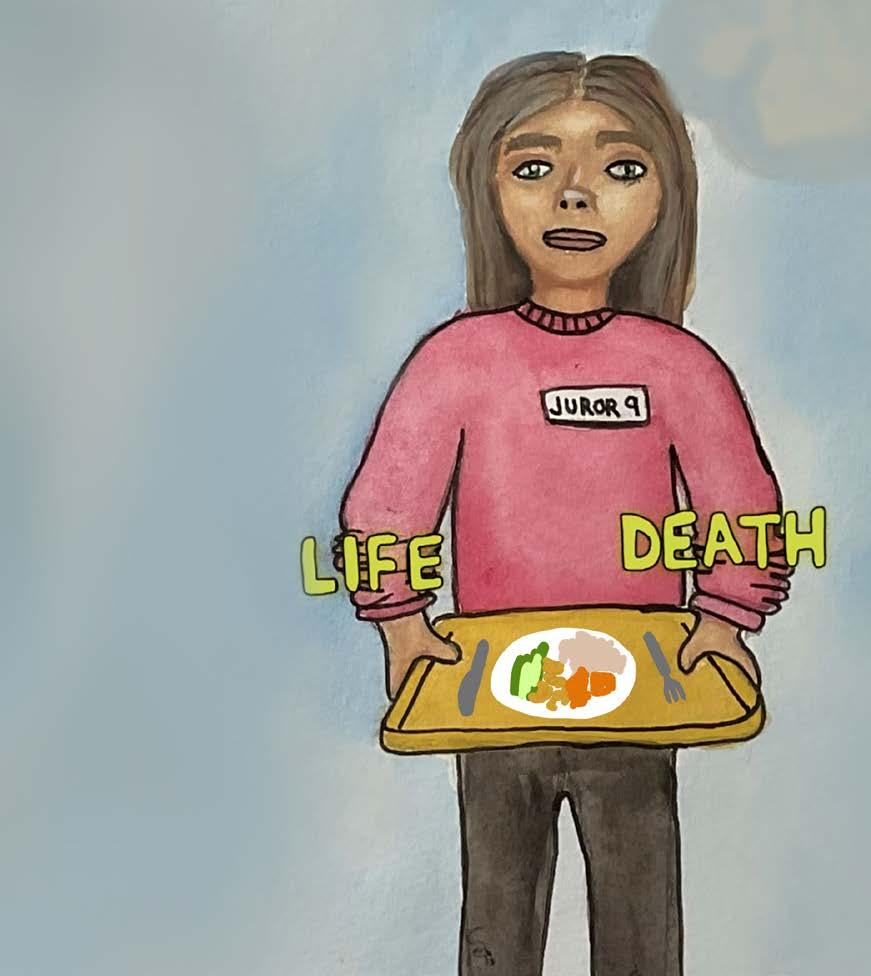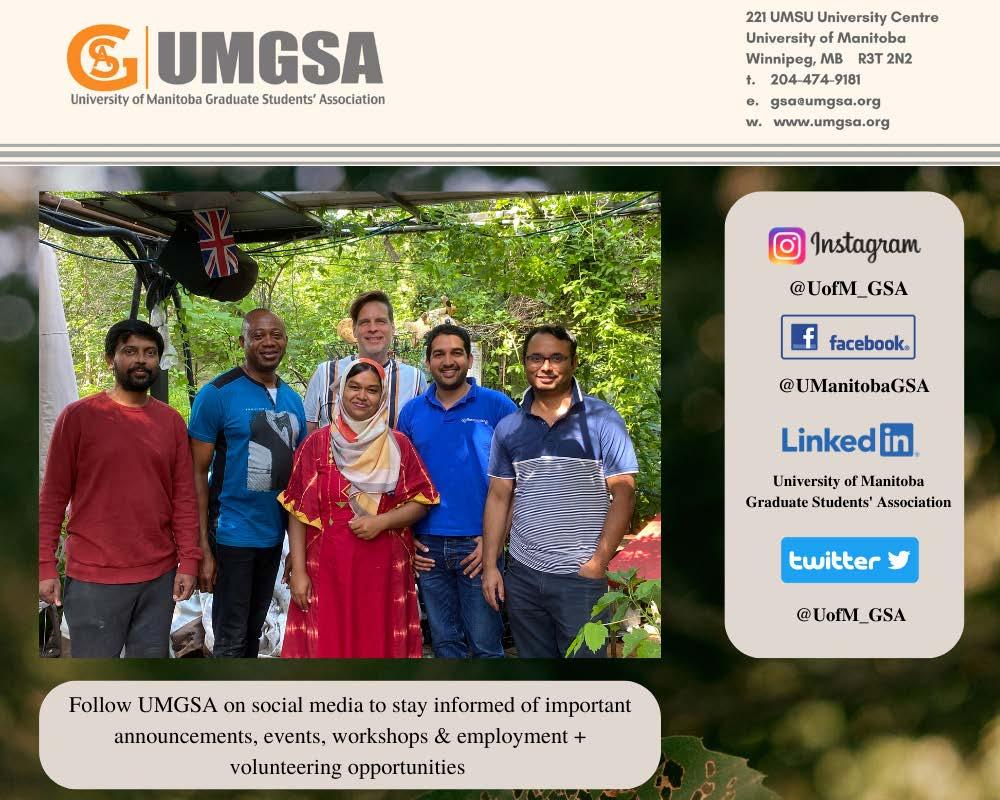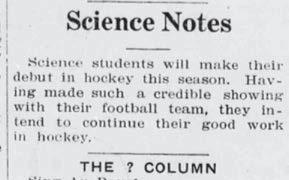



 The Official University of Manitoba Students’ Newspaper
The Official University of Manitoba Students’ Newspaper
Oct. 26, 2022 VOL. 109 NO. 11 SINCE 1914
EDITOR-IN-CHIEF ? editor@themanitoban.com
Gillian Brown
BUSINESS MANAGER ? accounts@themanitoban.com

Dhruv Patel
ADVERTISING CO-ORDINATOR ? ads@themanitoban.com

Richard Plant
MANAGING EDITOR ? me@themanitoban.com
Grace Anne Paizen
COPY DESK ? copy@themanitoban.com
Ezra Taves (ed.)
Morgan Heck
NEWS DESK ? news@themanitoban.com
Matthew Merkel (ed.) Colton McKillop (ed.)
Alicia Rose
RESEARCH & TECHNOLOGY DESK ? research@themanitoban.com
Elah Ajene (ed.)
Robert Moshe Thompson
COMMENT DESK ? comment@themanitoban.com Sarah Cohen (ed.) Braden Bristow Dina Hamid
ARTS & CULTURE DESK ? arts@themanitoban.com Alex Braun (ed.)

Damien Davis Jessie Krahn SPORTS DESK ? sports@themanitoban.com Kieran Light (ed.)

Quinn Mayhew
PHOTO DESK ? photo@themanitoban.com Ebunoluwa Akinbo (ed.)
Faith Peters
DESIGN DESK ? design@themanitoban.com Matthew Doering (ed.)
GRAPHICS DESK ? graphics@themanitoban.com
Dallin Chicoine (ed.)

Jenna Solomon
AUDIO DESK ? audio@themanitoban.com Harmatpreet Brar (ed.)
SOCIAL MEDIA DESK ? social@themanitoban.com
Jory Thomas (ed.)
Violet Baker

VOLUNTEERS THIS ISSUE ?
VOLUNTEER STAFF ? interested in volunteering? email me@themanitoban.com today!
THEMANITOBAN.COM 109 HELEN GLASS BUILDING UNIVERSITY OF MANITOBA WINNIPEG, MB 204. 474. 6535
The Manitoban is the official student newspaper of the University of Manitoba. It is published monthly during the summer and each week of regular classes during the academic year by the Manitoban Newspaper Publications Corporation.
The Manitoban is an independent and democratic student organization, open to participation from all students. It exists to serve its readers as students and citizens.
The Manitoban is a member of the Canadian University Press, and our journalistic standards can be found online at toban.news/jsp.
The newspaper’s primary mandate is to report fairly and objectively on issues and events of importance and interest to the students of the University of Manitoba, to provide an open forum for the free expression and exchange of opinions and ideas and to stimulate meaningful debate on issues that affect or would otherwise be of interest to the student body and/ or society in general. The Manitoban serves as a training ground for students interested in any aspect of journalism.
Students and other interested parties are invited to contribute to any section of the newspaper. Please contact the appropriate editor for submission guidelines.
The Manitoban reserves the right to edit all submissions and will not publish any material deemed by its Editorial Board to be discriminatory, racist, sexist, homophobic or trans-phobic, ableist or libellous.
Opinions expressed in letters and articles are solely those of the authors. Editorials in the Manitoban are signed and represent the opinions of the writer(s), not necessarily those of the Manitoban staff, Editorial Board or the publisher.
A “volunteer staff” member is defined as a person who has had three volunteer articles, photographs or pieces of art of reasonable length and/ or substance published in the current publishing year of the Manitoban.

Any individual who qualifies as a volunteer staff member must be voted in by a majority vote at a Manitoban editorial board meeting. Elected representatives and non-students may be excluded from holding votes as volunteer staff members in accordance with the Manitoban Constitution.
All contents are ©2022 and may not be reprinted without the express written permission of the Editor-in-Chief.

2 Vol. 109 No. 11 News pages 3 to 5 Research & Technology pages 6 to 7 Editorial page 8 Comment pages 9 to 14 Diversions page 15 Arts & Culture pages 16 to 19 Sports pages 21 to 24
Spook-tacular things to do this Halloween
How to spend your spooky season on and off campus
Matthew Merkel, staff
This Halloween, there are numerous celebra tions students can take part in. Now that there are no COVID19 restrictions in place, events and gatherings will be in full force this spooky season. The University of Manitoba Stu dents’ Union (UMSU) has a few events lined up for stu dents.
The UMSU Malpractice Halloween Social is scheduled to take place Oct. 28 from 9 p.m. to 2 a.m. in the multipur pose room on the second floor of University Centre.
UMSU vice-president com munity engagement Elishia Ratel said that the event will have lots of costumes and decorations, as well as drinks available for purchase and free pizza. Prizes will also be given out to those with the best costumes.
“It’s a great night for stu dents to be able to come together on campus and be able to enjoy a nice Halloween social,” she said.
Ratel said UMSU is also having a karaoke night at VW Social Club from 8 p.m. to 12 a.m. on Tuesday, Oct. 25. The five dollar cover charge will go toward the UMSU Holiday Hampers program which pro vides families in need with food and gifts in December.
The final UMSU Halloween event is a pumpkin carving night being held Thursday, Oct. 27 at 5 p.m. in the same multipurpose room. The five dollar entry fee for the event
will pay for a pumpkin, teal ight and carving tools. Snacks, pizza and goodie bags will also be provided.
Student groups are also holding Halloween events.
The Commerce Students’ Association is holding its annual Halloween Shocker social at Cowboys Roadhouse and Tavern United Wind sor Park on Oct. 29, and has already sold out of tickets.
The Arts Student Body Council is holding its Hallow een Social on Oct. 31 at VW Social Club from 9 p.m. to 2 a.m.
Off campus, there are a multitude of Halloween cele brations students can take part in.
A few Winnipeg nightclubs are hosting spooky themed nights over Halloween week end.
The Village Nightclub is holding a The Purge-themed Halloween celebration on Oct. 28 and 29. Infinity Ultra Lounge & Bar has two Hal loween nights set for Oct. 29 and 30. Emo Night returns to Cowboys Oct. 30. La Roca is holding a Halloween cos tume party on Oct. 28, while Obsidian Ultra Lounge is hav ing a similar event on Oct. 29.
Winnipeg Trolley Com pany’s Trolley of Terror Tour, a guided tour of some of Win nipeg’s most haunted destina tions, is available to book until Oct. 28.
Running till Oct. 30 at Assiniboine Park Zoo, Boo at the Zoo will feature costumed
actors, rides, games, food and Halloween displays.
WPG 19+ is hosting a couple events over the weekend at Assiniboia downs. On Oct. 28 and 29, its 19+ Adult Expo and Market featuring vend ors, food, tattoos, taboo con tent, cannabis and other items directed at people aged 19 and over will take place. Burlesque and pole dancing, hypno tism and a spanking seminar are some of the entertain ment highlights. On Friday night from 8 p.m. to 1 a.m., a Naughty Halloween party will also be held, and will include a costume contest as well as a drag show featuring Farrah Moan and Scarlett Bobo .
St.Vital Centre, Garden City Shopping Centre, Kildonan Place, Grant Park Shopping Centre and Outlet Collection Winnipeg are hosting trick-ortreating events on Oct. 31.
Outdoor interactive hor ror-themed spaces are also operating during the Hallow een season. Six Pines Haunted Attractions, A Maze in Corn, Deer Meadow Farms and Hee bie Jeebies are all operating throughout October. Heebie Jeebies owner Tim Muys said that after only being in busi ness for five years, the haunt is expecting nearly 30,000 visitors this year.
After having a couple of dif ficult years marred by COVID19 restrictions that forced reduced group sizes and social distancing on the prop erty, Muys said he is elated to see people able to freely enjoy
Heebie Jeebies this year.
The 70,000-square-foot property is located one kilo metre south of McGillivray boulevard inside the Per imeter Highway, about a 15-minute drive from the U of M.
Heebie Jeebies features four mazes, food trucks, photo ops, bonfires, merchandise vendors and free hot choco late. Across the entire prop erty, costumed actors roam around scaring visitors.
When asked how scary a night at Heebie Jeebies is, Muys said that each person’s experience varies. He said that specific fears, like clowns or claustrophobia, usually garner a reaction.

“We’re gonna get you at some point,” he said.
“We had a young boy that
was 12 years old and got half way through one of the mazes, he curled up in a ball and we had to carry him out,” Muys added.
“We had another person pass out this year, we’ve had a number of people pee their pants, that happens every year all the time. We’ve had two confirmed cases where people have actually crapped their pants, that we know for certain.”
However, Muys said that Heebie Jeebies provides an experience that the entire family can enjoy, adding that there is “an equal amount of screaming and laughing” among visitors.
UMSU holds breast cancer awareness fundraiser

Cookies are available for purchase at GPA’s or Degrees diner
Alicia Rose, staff
Each year, the breast Can cer Awareness Campaign is held in the month of Octo ber. In support of the cam paign this year, the Univer sity of Manitoba Students’ Union (UMSU) will be selling three-dollar cookies on cam pus at GPA’s campus conven ience store and Degrees diner throughout the month. All proceeds will go to the Can cerCare Manitoba Founda tion.
UMSU vice-president stu dent life Tracy Karuhogo said that the fundraiser has already seen successful sales.
Karuhogo said that UMSU will be ordering more cookies if they are sold out.
Karuhogo said that she is passionate about issues like breast cancer that affect women. She added that it is
important for UMSU to have events like this to show sup port for all people who are affected by the disease.
In 2021, the Public Health Agency of Canada reported that about two in five Can adians will be diagnosed with some form of cancer in their lifetime. It is estimated that one in four people die from the disease.
In Manitoba, 900 women are diagnosed with breast cancer every year, and 200 are expected to die from the con dition. Breast cancer runs in the family of only about 10 per cent of women who are diag nosed.
Breast cancer is among the most diagnosed cancers, along with colorectal, lung and prostate cancers. These cancers made up about 46 per cent of all diagnoses in 2021
alone.
The Public Health Agency recommends not smoking, having a healthy diet, incor porating physical activity into your daily life, having proper protection against the sun and getting screened for the disease to help reduce one’s chances of developing cancer.
CancerCare Manitoba emphasizes that because of breast cancer’s high rate of diagnosis and fatality, it is important for women over the age of 50 to have sched uled mammograms every two years. Depending on bio logical factors, transgender and non-binary individuals might require regular screen ings as well.
Being screened regularly for breast cancer decreases its mortality rate by about 20 to 30 per cent for women
between the ages of 50 and 74.
There are multiple mam mogram clinics across the province, and a Winnipeg clinic is located at 5-25 Sher brook Street. Appointments can be made by calling 1-855952-4325.
Karuhogo said that stu dents should keep an eye out for future UMSU fundraising events like Movember next month, a campaign that raises
awareness regarding men’s mental health, prostate can cer and testicular cancer.
Karuhogo recommended that students check out the UMSU website or Students of UMSU Instagram page for more information on current and future events.
3 news@themanitoban.com October 26, 2022 NEWS.
news@themanitoban.com image / Heebie Jeebies / provided
news@themanitoban.com
photo / Faith Peters / staff
Performance-based funding still on the table for Manitoba universities
Gillian Brown, staff
D espite concerns from university faculty and the official Opposition, the prov incial government is still con sidering a performance-based funding model for universi ties in Manitoba.

The decision to look into a performance-based funding model came after responsib ility for post-secondary insti tutions was moved from the Department of Education and Training to the Department of Economic Development and Training. It now sits under the Department of Advanced Education, Skills and Immi gration.
The provincial government has been consistent in its intentions to tailor post-sec ondary education toward the needs of the Manitoba labour market. In its Skills, Tal ent and Knowledge Strategy released in February 2021, one of the objectives outlined was to “align education and train ing to labour market needs,” and one of the immediate actions recommended was to create a new funding model based on performance and outcomes.
When the recommenda tion was first brought forward by former Premier Brian Pal lister, the province was con sidering the Tennessee model of funding.
Universities in Tennessee receive the majority of their state funding based on out comes, considering metrics like number of degrees awarded, graduation rates and number of credit hours earned.
In contrast, a recent Statis tics Canada report on univer sity funding found that Can adian universities received the majority of their funding from the province in the 2020-
21 fiscal year. The report high lighted that the amount of funding received continues to decrease, with institutions looking to tuition to make up the loss.
In the past, reductions to provincial fund ing in Manitoba have caused the U of M to rely more heavily on tuition for its operations.
Jamie Moses, critic for advanced edu cation and eco nomic develop ment, said that the actual framework of the potential model has not been released by Minister of Advanced Education, Skills and Immigration Jon Reyes’s office, but that it appears a plan for performance based funding is in the works right now.
Moses also stated that the minister has not released details concerning the metrics the funding would be based on, or how much funding would be tied to performance.
He voiced his concern, and said that he has heard “a very strong opposition to perform ance-based funding both from faculty members and from students, who see a huge, huge risk to advanced educa tion in Manitoba.”
“Anything that makes fund ing more difficult to advanced education or makes advanced education more unaffordable or more inaccessible only goes to hurt students, our universi ties and colleges, and ultim ately, our economy in Mani toba,” he said.
Moses referred to Bill 33, a controversial amend ment to the Advanced Edu cation Administration Act, that granted the minister the
ability to issue guidelines for tuition fees and student fees set by a university.
According to Moses, because the bill permits the minister to change tuition at the ministerial level, funding
University faculty, Opposition strongly against the model
could be affected as well.
“It enables the minister to have more freedom and con trol […] and that could over ride the goals or the objective of an administration, or even a student body.”
The bill also rang alarm bells for Manitoba Organiza tion of Faculty Associations (MOFA) president and Uni versity of Winnipeg biology professor Scott Forbes, who said that “beyond just train ing students to fill jobs in a local economy, universities perform a much broader role,” and that they require auton omy to fill that role.
A bill similar to Bill 33 was struck down in Ontario in 2019, with the court rul ing that the government was interfering with the autonomy of universities.
Aside from the function of educating students and devel oping key skills, which Forbes said is key, university faculty curate knowledge that cre ates a body of experts used by the public at large, who often lend their expertise to media broadcasts or times of crisis.
Forbes said that a large objection MOFA has to per formance-based funding in
general is that “it doesn’t work.”
Research at universities in the U.S. have shown that per formance-based funding does not achieve its policy goals, often having minimal to no effect on stu dent retention and graduation. Over time, it can even reduce the amount of skilled work ers entering the workforce.
MOFA has been opposed to the model since it was first intro duced in Manitoba, and most recently, presented a brief to the province outlining its members’ concerns.
Forbes said that perform ance-based funding results in institutions exploiting the system, and that “in some cases, the unintended conse quences are disastrous.”
He explained that universi ties may become more exclu sive, shifting funding away from supports for low-income students and potentially turn ing them into scholarships for high-achieving students instead.
“This distorts the whole system, and it raises barriers to many groups, especially traditionally marginalized groups,” he said.
Further, Forbes explained that the move may be a way to disguise post-secondary fund ing cuts, with the province potentially using the univer sity and its metrics as a scape goat to reduce funds.
“It’s really an attack on pub lic education, full stop,” he said.
The decision to consider performance-based funding was influenced by a report from the auditor general
released October 2020, which raised governance and finan cial concerns after examining seven post-secondary institu tions in Manitoba.
Despite these concerns, MOFA objects to the idea that performance-based funding is the way to improve fiscal over sight. Instead, the organiza tion’s brief suggested increas ing training for the board of governors, or establishing a governmental body to oversee the budgeting process.
Minister Reyes declined request for an interview, but spokesperson Brant Batters said in an email statement to the Manitoban that read, “the province is trying to improve accountability and oversight for the significant amount of public funding the province provides to post-secondary institutions to help illustrate the value Manitobans expect.”
Batters referred to the 2020 audit, which recommended the development of an out comes-based funding model. The audit claimed that tying funding to performance would “serve as an essential component of an accountabil ity framework going forward.”
Batters said that the department is engaging with post-secondary institutions, faculty associations, student groups and Indigenous gov ernment organizations on an accountability framework, because “a well-developed framework can support greater oversight for the use of public funding,” and that it may “improve the depart ment’s ability to report on Manitoba’s institutions’ posi tive outcomes to the public.”
4 news@themanitoban.com Vol. 109, No. 11NEWS
photo / Faith Peters / staff
“It’s really an attack on public education, full stop”
— Scott Forbes, Manitoba Organization of Faculty Associations president
news@themanitoban.com
Court rejects legal injunction to stop UMSU referendum Campaigning resumed following judge’s decision
Colton McKillop, staff
A motion for a legal injunction filed by the Canadian Federation of Stu dents, aimed at stopping UMSU’s planned referendum on the student union’s con tinued membership in the federation, was dismissed by the Court of Kings Bench on Monday.
Campaigning for the ref erendum was briefly sus pended while UMSU awaited a decision from the court on whether the referendum — which is scheduled for Oct. 27 and 28 — would be allowed to go forward.
“The referendum cam paigning, which included campaign websites, social media and on-the-floor cam paigning among other activ ities, was put on hold at the direction of the CRO on Tues day morning following a con sultation meeting with the UMSU board of directors on Monday evening,” UMSU president Jaron Rykiss told the Manitoban in an email on Saturday.
Rykiss also said that UMSU would not know whether the referendum would proceed on the scheduled dates until they received a decision from the court.
In a text message to the Manitoban on Monday, Rykiss called the decision “a huge win for democracy,” and said that the sides would “resume campaigning right away.”

“Our student body deserves to vote here,” he added. “We want them to have that abil ity!”
“The injunction looked to prevent the student voice from being heard. We are against that.”
The Instagram account for the pro-leave side, @vote. no.demand.better — which was made private following the injunction — is once again public.
Posts made on the account before it was made private
claimed that the referendum will cost UMSU approximately $10,000 to run.
Rykiss was unable to con firm this figure due to con cerns regarding UMSU’s ongoing legal disputes with the Canadian Federation of Students.
Dispute over online voting
The relationship between UMSU and the federation has been conflictual for years, with UMSU making numerous attempts to defederate since 2013.
In recent years, online vot ing has been a particularly contentious issue between the two organizations.
The Canadian Federation of Students’ rules require that member organizations must hold a referendum of their membership before deciding to defederate.
The federation has already ignored previous requests from UMSU for online vot ing during the COVID-19 pan demic.
The student federation is currently suing UMSU for withholding three years’ worth of fees totalling more than $1 million.
UMSU withheld the fees in protest of the federation’s refusal to allow the student union to operate a referen dum using online voting.
UMSU plans to conduct the referendum this week using online voting, both from stu dents’ personal devices and an online voting booth in Uni versity Centre.
Federation injunction dismissed
The federation amended their statement of claim against UMSU on Oct. 14 to “seek relief with respect to the referendum, including an interim/interlocutory and permanent injunction.”
The injunction—an order that restrains one party from an action that threat ens to invade the legal right of another—stopped UMSU from campaigning temporar ily.
Once the injunction was dismissed, campaigning resumed.
In addition to requiring a referendum, the Canadian Federation of Students bylaws state that any member organ izations must pay all out standing fees six weeks before a defederation vote.
UMSU argues that the fed eration’s bylaws do not apply to it, as it is bound to follow the University of Manitoba Stu dents’ Union Act and its own bylaws. The bylaws require the board to vote on mem bership in external organiza tions every two years, and to terminate membership if the vote fails to achieve a major ity.
Motions to affirm UMSU’s membership in the federation were defeated in 2018, 2020
and 2022.
UMSU also asserted that the Canadian Federation of Students has refused to ful fil its contract with the union — and therefore freed UMSU from the federation’s defeder ation process — by failing to address issues that UMSU has brought forward for years, and for refusing to accommodate the request for online voting during the pandemic.

The Canadian Federa tion of Students argued that its bylaws regarding referen dums predate UMSU’s bylaws and asserted that “the UMSU bylaw cannot retrospectively affect the rights of the par ties.”
The federation asserted that allowing the referendum to move forward would under mine their voting protocols and may lead other student associations to follow UMSU’s example.
The court disagreed, rul ing that the federation had not provided compelling evi dence that allowing the ref
erendum to take place would cause “irreparable harm,” and dismissed the concern about other student unions follow ing UMSU’s example as specu lation.
The court also asserted that the federation’s goal “appears to be preventing decertifica tion,” and that the organiza tion was primarily concerned with preventing the loss of revenue this would cause.
The Canadian Federation of Students has a reputation for being challenging to leave, with the organization seek ing legal action against other student unions that have attempted to defederate.
Earlier this month, the Ontario Superior Court of Jus tice ordered the Carlton Uni versity Students’ Association to halt its non-binding refer endum on continuing mem bership with the federation.
5 news@themanitoban.com October 26, 2022 NEWS
photo / Ebunoluwa Akinbo / staff
news@themanitoban.com
What is stopping human cloning? U of M professor explains ethics behind its illegality
Elah Ajene, staff
The theme of “cloning” is common within the sci ence-fiction and horror film genres — often tagged with apocalyptic views in main stream media and pop cul ture. Filmmakers like Jordan Peele have familiarized their audiences with the reccur ring theme of cloning in mov ies like Us, with “murderous doppelgangers” due to failed experimentations in creating human clones.
Cloning is a particu larly interesting film con cept because of its biological nature, but is it purely fiction or are there hints of reality?
University of Manitoba pro fessor of philosophy Arthur Schafer said on the topic, “at the moment and for the fore seeable future, human repro ductive cloning is science fic tion, it’s fantasy.”
In 1996, Dolly — a female Finn Dorset sheep — became the first mammalian clone in existence. This success by sci entists at the Roslin Institute in Scotland served as a great scientific milestone. How ever, this excitement opened a pandora’s box of questions and was quickly followed with public debates on the pros pects of human cloning.
Despite the obvious techno logical advancements in almost two decades since the creation of Dolly the sheep, why have we still not seen human clones?
“Cloning” as described by the National Human Genome Research Institute is a range of processes which “produces genetically identical copies of a biological entity.”
In nature, there are organ isms that generate exact rep licas through asexual repro duction processes, without genetic recombination or alterations. Binary fission in bacteria and flatworms, frag mentation in starfish and spore formation in mosses and ferns all produce clones of the parent organism.
Identical twins are another variation of natural clon ing in which a single fertil ized embryo develops into two individuals with the exact same genetic composition.
Reproductive cloning, which is a form of arti ficial cloning, produces a copy of an entire animal.
In humans, this would involve using either som atic-cell nuclear transfer — creating an embryo from an egg cell and somatic cell — or embryo splitting, which is the formation of two identi cal individuals by the micro surgical splitting of a single embryo. Both methods are fol lowed by the implantation of the embryo in the uterus for
further development and ges tation.
Although cloning technol ogy has not been used to cre ate a human clone yet, Schafer explained that it is widely employed in agricultural bio technology for commercial purposes. Applications are seen in the livestock food industry, such as with dairy cows or bacon hogs, for effi cient production.
“That was indeed the ori ginal motive and incentive for the Roslin Institute in Scot land to develop the technol ogy,” he said.
Human therapeutic cloning
cells in order to treat certain genetic conditions,” Schafer explained.
There are several ethical and social considerations sur rounding both human repro ductive and therapeutic clon ing.
Though there have been some successful therapeutic treatments developed, over all, Schafer describes the return on investment of these technologies in treatment of human diseases as “thin,” as only a small number of dis eases have been efficiently treated.
tries across the globe. In Can ada, under the 2004 Assisted Human Reproduction Act, human embryonic cloning is prohibited.
According to Schafer, the main ethics behind the ban is the inefficiency of the technol ogy. The likelihood of creat ing a “healthy” baby through human reproductive cloning is miniscule.
“It’s likely to remain illegal until, or unless, animal clon ing technology so advances that human cloning technol ogy looks as if it would be safe and effective,” he said.
on the other hand involves the cloning of human embryos for stem cell production. Stem cells are unspecialized self-renewable cells capable of developing into different cell types. Isolated stem cells from the cloned embryos are used in regenerative medicine as sources of cells for tissue engineering and transplanta tion medicine.

“The technology has been used to clone human stem
“It’s difficult to know when, if ever, this technol ogy will pro vide effect ive cures,” he said. Notwith standing, many bio tech com panies are investing in research and working on expanding the efficacy of these technologies.
“The investment is very great, and the potential prof its [if] the cures can be pat ented and turned into money machines, that potential profit is in the billions,” Schafer said.
However, human repro ductive cloning is met with strict legislative con straints, with explicit bans in approximately 46 coun
When technologies have progressed to this point, fur ther public discussion on whether it is morally permis sible as another reproductive technology would undoubt edly occur.
“After all, there was an enormous public concern, anxiety and debate about pre vious reproductive technolo gies, including in vitro fertiliz ation and embryo transplant ation,” Schafer explained.
“There was great public anxiety not so many decades ago, but now there have been millions of babies born world wide using this technology.”
research@themanitoban.com
6 research@themanitoban.com Vol. 109, No. 11.RESEARCH & TECHNOLOGY
graphic / Dallin Chicoine / staff
“At the moment and for the foreseeable future, human reproductive cloning is science fiction, it’s fantasy” — Arthur Schafer, bioethicist and professor of philosophy at the U of M
How plasma is changing the way we treat infections
U of M leads national clinical trial to fight severe infections
Robert Moshe Thompson, staff
The human immune sys tem exists to protect our bodies from disease, but sometimes a person’s immune response can cause just as much harm as the dis ease itself.
For example, the body cures infections by producing a fever, because disease-caus ing organ isms have a more difficult time surviving in abnormal body temper atures. How ever, a fever that is too high for too long may damage the body.
Ryan Zarychanski, a physician-sci entist at the U of M, is run ning a clinical trial with fellow hematologist Emily Rim mer. The trial studies patients with infections that are severe enough to require treatment in an Intensive Care Unit (ICU).
“You get really febrile, because that’s your body’s way of fighting off infection,” Zarychanski said — febrile meaning showing signs or symptoms of a fever. “But some people get so febrile that they have a seizure.”
About 30 per cent of patients with such severe infections will die, but often due to inflammation and blood clotting rather than the disease itself. 20 years ago, that figure was even higher,
close to 50 per cent.
Zarychanski and Rimmer aim to reduce this mortality rate by changing the approach to treatment.
So far, the only reliably effective treatment for infec tions is antibiotics, which tar get the actual bacteria.
blood. The inflammatory plasma proteins would then be extracted and replaced with plasma proteins from a healthy donor. Zarychanski referred to this extraction and replacement process as “puri fying” the blood.
This purification is simi
of treating infection. This would not only affect indi viduals with life-threaten ing infections, but also other more common infections that are normally treated with anti biotics, such as pneumonia.
Although children and the elderly are more likely
will transform the trial from a national to an international investigation. Zarychanski and Rimmer have connec tions with clinical researchers in the United States, Australia and Europe.
Instead of addressing the disease-causing agent, the clinical trial focuses on reducing unnecessary inflam mation.
Much of the inflammation in an infected person’s body is caused by inflammatory proteins in plasma, one of the basic components of blood along with red blood cells, white blood cells and plate lets.
Plasma is separated from the other components of blood through a process called plas mapheresis. When separated, blood is 55 per cent plasma, 44 per cent red blood cells and one per cent white blood cells and platelets.
The trial proposes to treat infection inflammation by removing an infected person’s
lar to dialysis, a process that replaces the function of the kidneys, which remove tox ins from the blood. The per son’s blood is removed, put through a purifying machine and returned to the patient.

Rather than removing tox ins, then, plasmapheresis removes plasma, allowing doctors to replace inflamed proteins with healthy ones.
This treatment differs from traditional infection treatments in that it is not focused primarily on antibiot ics. Increased dependence on antibiotics to treat infections has caused some bacteria to become antibiotic resistant.
If antibiotic resistance con tinues to rise, the medical community will be in danger of losing its primary method
to develop severe infections, Zarychanski stressed that anybody of any age or health status can be affected by them.
“You could be the 18-yearold, healthy football star who gets meningitis from spread ing in the locker room, or you could be the sick person with cancer who’s had it for 10 years, so anyone can get an infection,” he said.
A unique aspect of Zarychanski and Rimmer’s trial is the fact that the data required for the trial is co-or dinated by the University of Manitoba. That makes it the first large national clinical trial operated primarily from Manitoba.
The trial’s first phase is run in Canada, and if it is suc cessful, the second phase
Since plasma cannot be synthesized, it must be sup plied by donors. Pro metic Plasma Resources is a centre at the University of Manitoba’s research and technology park where individuals can become plasma donors. Their plasma is used to treat blood disorders such as hemophilia, and to make medications for people with compromised immune systems. Compon ents of plasma can also be used to make diagnostic tests for certain diseases.
“Plasma is not a substance that can be produced in a lab oratory or some other artifi cial environment,” the cen tre’s page explained.
“It can only be obtained from healthy adults. When you donate plasma, you are helping to save lives.”
7 research@themanitoban.com October 26, 2022 RESEARCH & TECHNOLOGY
research@themanitoban.com
graphic / Jenna Solomon / staff
“You could be the 18-year-old, healthy football star who gets meningitis from spreading in the locker room, or you could be the sick person with cancer who’s had it for 10 years, so anyone can get an infection”
— Ryan Zarychanski, physician-scientist at the U of M
The unremarkable is revealed by planetary defence test NASA mission favours sensationalism over experimental rigour
Matthew Doering, staff
It was on Sept. 26 that
NASA’s Double Asteroid Redirection Test (DART) — after traveling for 10 months with a trajectory aimed at a small rock in the name of planetary salvation research — made contact and col lided with Dimorphos, a small asteroid about half the height of the Eiffel Tower.
Earlier this month NASA declared the mission, which had the goal of pushing the asteroid a small distance closer to the larger asteroid it orbits, a success. This suc cess took the form of shrink ing the time to orbit by about four and a half per cent. This effect is over 25 times greater than the 73-second change in time to orbit initially defined for success.
NASA applauded this feat. It was a failure on several fronts.
Poor experiment
An experimental object ive of throwing one object at another and wondering if there will be a perceptible transfer of energy is a backof-the-napkin problem for a physics student. As anyone with any experience in the physics of snooker or car colli sions can attest, the answer is a definite yes.
Assuming successful colli sion, declaring experimental success was assured from the start, and so this was less an exercise in scientific discov ery and more a PR opportun ity to bring the terms of “plan etary defence” via “kinetic impact” to the public fore.
Impractical
A couple of decades would be necessary to attempt to divert a newly discovered asteroid from a collision course with Earth, and while there are currently no known asteroids on such a course for the planet, the sun’s glare hides any asteroids behind it, leaving a vacant expanse in the asteroid landscape around Earth in the coming decades and centuries.
With a planned launch for the first half of 2026, the NearEarth Object Surveyor tele scope project hopes to fill in that picture. A worst-case scenario would reveal pre viously unknown asteroids headed toward Earth that are a matter of years away. This would leave too little time to undertake a kinetic impactor mission.

A nuclear option for redi recting such an asteroid on a timeline of less than a dec ade is still considered to be
the best option, according to a study published last year in the research journal Acta Astronautica. The limiting factor, however, is still the United Nations’ Outer Space Treaty prohibiting nuclear weapons in space and the complex, possibly impossible, international negotiations that would be needed to allow a nuclear missile into outer space, even were it for the pur pose of asteroid deflection.
Environmental impact
NASA defines astrobiol ogy as “the study of the origin, evolution, distribution and future of life in the universe.”
From there, astro-ecology can be defined: how organisms, namely humans, interact with the broad cosmic envi ronment and its resources.
Asteroids and meteors fall within the umbrella of cosmic resources and environments.
A project undertaking such a stark remodelling of land scape, changing the orbit of an
asteroid with the DART mis sion would require an envi ronmental impact assessment on Earth. And indeed, such assessments are performed for space missions, but only in terms of the launch itself, i.e. possible impacts on Earth. Sending a fridge-sized object on a one-way trip to initiate an intergalactic rubbish heap needs no such meaningless document preparation efforts.
Take only pictures, leave only footprints. But only if you are on Earth. In outer space? Take orbits. Leave debris, refuse, rubbish, waste of all kinds, with no plan to return to sender.
The cost
With a price tag of US$325 million, DART was an expen sive crash-test refrigerator. This is about as much money as World Vision Canada’s total revenue in 2021. It is enough to fund CARE Canada’s oper ations for about three years, at 2020-21 levels. It is more than
the 2021 program expenses for the World Wildlife Fund’s U.S. arm. It is about as much as Amnesty International’s fundraising in 2020. All funds that would go towards helping the immediate needs of the people and animals living on our planet.
A follow-up project is planned by the European Space Agency to take place in several years’ time. It is an invaluable first investment in deflecting an as yet unknown asteroid threat, a threat for which the technology is cur rently not available to detect.
The verdict
A complex piece of metal was launched at a space rock earlier this year with the goal of pushing it. This imple mentation and realization of
a seemingly midnight backof-the-blue-cheese-buffalochicken-wing-sauce-stainedPilsner-moistened-napkin calculation resulted in the complex piece of metal push ing the space rock.
The question this raises, and the most logical oppor tunity for future research, is this: if an object is pushed harder, will it move farther? And, as a sobering early mor ning thought, the path to the survival of the planet is through the establishment of remote outposts of electrical, mechanical, industrial scrap and waste.
8 editor@themanitoban.com Vol. 109, No. 11.EDITORIAL
editor@themanitoban.com
graphic / Dallin Chicoine
/
staff
DART was an expensive crashtest refrigerator
Tomato soup and spilled milk
New age protests are ineffective in their pursuit of change
Dina Hamid, staff
It has been a busy two weeks for liquid foods, which unexpectedly shot up in popularity as the weapon of choice for climate and animal activists alike.

Heinz tomato soup was the catalyst that caused two Just Stop Oil protesters to make international headlines, after the product was poured on Vincent van Gogh’s 1888 “Sunflowers” painting at the National Gallery in London on Oct. 14.
This stunt was a response to the U.K.’s cost of living crisis and a denouncement of the use of fossil fuels. The protest ers were arrested following the incident, and the painting was cleaned and brought back for display six hours later.
Similarly, Animal Rebel lion protesters have spilled milk on the floors of super markets in the U.K. multiple times in the last few months to voice their opposition of dairy products due to their signifi cant contribution to environ mental pollution.
Both these protests were met with a series of differ ent reactions, from support to confusion, to outrage and irritation. Is every protest a good one just by virtue of tak ing place and garnering atten tion? I don’t believe that to be the case. Protests without definitive goals of advocat ing and promoting reform are nothing more than short-lived placeholders for news outlets until the next big story.
I must admit that these actions are effective at starting discussions, grabbing atten tion and putting an organiza tion’s name in the public eye, but that is all they do. Often times their intended purpose is just performance, and less individuals are likely to sup port these types of protests. I believe that winning the sup port of individuals is essential for change, especially regard ing the maintenance of our shared planet.
Fighting climate change is different from previous social movements. It will have an inescapable negative effect on every inhabitant of the Earth if not dealt with quickly and properly. This is important, as many Western people tend to have individualist views that manifest themselves in the centring and importance of oneself. Therefore, unless a cause directly affects West ern people, it is unlikely that many of them will care all that much about it.
Climate change benefits no one. It will negatively affect every single living being on this planet. That is, unless you count the nice weather days
before the polar ice caps melt and potentially flood every major coastal city. At least the weather will have been nice for some time.
With that being said, we should always be in solidar ity with global social move ments for change and espe cially for climate action, and the fact that we aren’t is not a good sign.
Fighting climate change is not a one-man job. We all need to collectively adapt and participate in sustain able and environmentally friendly behaviour to ensure the possibility of many tomor rows. If we are not all in agree
Climate change benefits no one
ment and do not develop new behaviors, habits and life styles, the time we have to bring about real social change will pass and all of our efforts will be for nothing.
The climate crisis is a tick ing time bomb, with a deton ation time that can be either sped up or slowed down.
It is vital to obtain public support for climate change efforts in order to imple ment corporate and govern mental policies that will help the environment. More effect ive non-violent protest tactics that are aimed at the source of the problem or those with the power to change it are neces
sary in order to do this.
We can continue to raise awareness but I would assume that everyone within a 20-meter radius of Wi-Fi is aware of the climate crisis. Especially considering that scientists predicted and warned about the effects of climatic changes in the atmos phere as early as 1896.
Although I commend these activists for their vali ant actions and strongly sup port their cause, it does not exempt them from construct ive criticism.
Real reform is urgently needed, and getting every one on board and winning the
public over is our best chance of success. It is not enough to stage protests that gener ate attention than about the actual problem at hand.
It is in everyone’s best inter est that we all globally sup port and mobilize for climate action by doing the work our selves, and by electing cli mate-aware politicians that can put regulations in place to protect our planet. If we fail in that, our home will cease to exist.
9 comment@themanitoban.com October 26, 2022 COMMENT.
comment@themanitoban.com
graphic / Jenna Solomon
/
staff
Suffering for life No punishment is harsh enough for Florida school shooter
Sarah Cohen, staff
As a former U.S. student, I am lucky enough to have never had the experi ence of hiding in the back cor ner of a classroom, trembling with fear and hoping that an active shooter would not open the door.
My parents are lucky enough to have never gotten a text from me telling them I love them and that there is someone armed and with ill intent on my campus. We are lucky to not be a family at one of the 35 schools this year alone in the United States that have been faced with this.
American students should not be fearful for their lives attending school every day. The fear and the anxiety expand past graduation day. I can tell you that even in a country scarce with school shootings, I am still making a plan in my head every time I enter a school setting.
The Parkland shooting on Feb. 14, 2018 emphasized the danger that many schools across the U.S. face, and their need for higher safety meas ures and preparedness for emergencies.
My California high school had active shooter drills. The sound of that bell is etched in my mind. It sounds like any other school bell, but my school had the philosophy that bells interrupt the learn ing environment and didn’t have regular bells during the day. The tone does its job and readies my body for flight, fight or freeze.
It has been nearly five years since Nikolas Cruz, now 24, entered Marjory Stoneman Douglas High School in Park land, Florida and killed 17 people, injuring 17 more. Cruz pleaded guilty to the mass shooting.
After a six month senten cing trial, a jury of 12 recom mended that Cruz be sen tenced to life in prison with out the possibility of parole on
Thursday, Oct. 13 of this year. The jury was asked to decide whether Cruz would receive the death penalty or life in prison.
The death penalty could only be given with a unani mous decision by the jury, and was overruled by the votes of three jurors.
The choice the jury had was tough, with either side as con troversial as the other. They were bound to get backlash no matter their decision.

Responses from the families of victims, such as “today’s ruling was yet another gut punch,” and “I pray that that animal suffers every day of his life in jail” illustrated the dev astation some felt at the news that Cruz would not be put to death.
No one deserves to die. Not the 17 at Marjory Stoneman Douglas. Not Nikolas Cruz.
Cruz committed heinous crimes and took children from their parents, but death is too easy a punishment. Instead, Cruz will live every single day for the rest of his life in prison.
I know the saying is “an eye for an eye” and that aven ging murders is a tale as old as time, but no person deserves to die. The goal of the crim inal justice system should be to help people learn their les son, not to kill more people.
I don’t think that any pun ishment is harsh enough for Cruz. Yes, he may have stayed on death row for a number of years waiting for his execu tion date, but during this time he could appeal the sentence and that date could be pushed back and back. The victims would be waiting for closure, constantly reminded of their trauma.
I want Cruz to live the rest of his life serving his time. I don’t want that time to be the few years it takes for an execu tion.
He will never experience freedom again. Cruz will suf fer for the rest of his life rather
than the mere minutes it takes for a death sentence to be car ried out.
Execution as a form of pun ishment in the U. S. should have been abolished decades ago, but being put to death seems to have been the con sequence of choice for centur ies when it comes to crimes as heinous as mass shootings, and remains an option in over half the states in the U.S.
Over 70 per cent of countries worldwide have abolished the death penalty, including Can ada. Countries where capital punishment still exists tend to have large populations and
undemocratic governments.
The U.S., despite being a liberal democracy and having allies that have abolished the death penalty, still executes prisoners every year, innocent or not.
My argument is not that Cruz should not be let off easy, but that putting people to death should never be the solution. I could talk for hours about the U.S. criminal justice system, but for brevity’s sake, all I will say is that things need to change to make the system more humane.
By avoiding the death pen alty, Cruz’s victims can hope
fully know that Cruz will be getting the punishment he deserves.
I feel saddened for the fam ilies that feel justice will not be served. I can’t imagine the grief of losing a child at the hands of someone else.
However, I am content that Cruz will spend every day at the mercy of the U.S. prison system rather than being released from life relatively soon.

10 comment@themanitoban.com Vol. 109, No. 11COMMENT
graphic / Jenna Solomon / staff
comment@themanitoban.com




MENTAL HEALTH ART CALLOUT We are looking for student artwork to be featured in an interactive mental health exhibition, Unravel The exhibit will run from November 15 - 18 Deadline for submissions is October 31, 2022. Interested or want to learn more? Scan the QR Code! ALL FORMS OF ART ARE WELCOME! HERE IS WHAT’S HAPPENING FOR HALLOWEEN! Visit umsu.ca/events for more details! UMSU EXECUTIVE OFFICE HOURS (Fall 2022) Elishia Ratel VP Community Engagement TUESDAY @ 12PM Jaron Rykiss President MONDAY @ 12PM Victoria Romero VP Advocacy FRIDAY @ 11AM Brook Rivard VP Finance & Operations THURSDAY @ 12PM Tracy Karuhogo VP Student Life WEDNESDAY @ 12PM HALLOWEEN KARAOKE NIGHT OCTOBER 25TH 8PM-12AM VW SOCIAL CLUB ENTRY FEE: $5 DONATION UMSU Holiday Hampers Program OCT. 27TH 5PM-8PM Multipurpose Room (MPR), 2nd Floor UMSU University Centre Cost: $5 (through Eventbrite) Scan QR Code and get your tickets today! OCT. 28 9PM - 2AM 2nd Floor UC (In the MPR) UMSU PRESENTS HALLOWEEN SOCIAL TICKETS: $25 SCAN TO GET YOUR TICKETS! WWW.UMSU.CA @MyUMSU WWW.UMSU.CA @MyUMSU
Haven’t you heard? Hot people dress up for Halloween
From Wonder Woman to Freddy Krueger, don’t be boring, dress up
Jory Thomas, staff
As social media editor at the Manitoban, I scroll through every social media platform all day, every day.
Although we don’t have a TikTok, I can admit that it is where I spend the most time.
Since it was created, so much of social culture has stemmed from TikTok. No matter where you go, TikTok seems to follow. Even though most TikTok frequenters are young people, the app influ ences everyone. TikToks are all over Instagram and Face book as reels, spreading new trends, information and gos sip like wildfire.
Every couple of months, trends centring women, cloth ing and certain aesthetics cycle through the app.
In the summer, TikTok users were introduced to the “clean girl.” This is the type of girl that wears a slickedbacked bun, has a wardrobe that carries only the basics, and only wears minimal makeup. My feed was flooded with how-tos on being a clean girl, which involved clothing hauls and makeup tutorials. Even fast fashion brands like Shein shifted from colourful sweaters to bland, minimalist clothing.
After this, the cycle repeated with the emer gence of the “rockstar girl friend.” The rockstar girl friend wears leather, red lip stick, has a wolf-cut hairstyle and only listens to bands that you’ve never heard of. Typ ically, these videos are usually accompanied by a popular
song, which causes them to skyrocket to success.
Unfortunately, trends like “clean girl” and “rockstar girl friend” promote judgement, insecurity, exclusivity and consumerism. If you can’t look a certain way or buy into the trends, you’re totally not cool.
These are trends I do not support.
One trend I do support, however, is “hot girl Hallow een.”
Now, don’t get confused, this trend is not just for women. This is a trend that truly celebrates Halloween.
As summer came to an end and Spirit Halloweens open in vacant strip mall locations across the continent, I start hearing “This Is Halloween” from the Nightmare Before Christmas and the costume TikToks start flooding in. These TikToks ranged from basic to obscure, from glam ourous to downright disgust ing, and they were undeniably fun to watch.
Aside from being entertain ing, these videos also inspire the masses to dress up. Unlike other trends that encour age judgement, comments are flooded with support and people expressing their desire to dress up as their favourite characters, and to feel valid ated by fellow TikTokers.
These costumes range from rapper Easy-E to Dani from Midsommar. The majority of costumes you come across through the hashtag, #hotgirl halloween, are also demon strated as being easy to do and
affordable.
Unlike the “clean girl,” this is a trend that I believe needs to heavily influence soci ety. Since I turned 14, all my friends have deemed Hallow een to be cringey and social media has usually encouraged the same. In one of my classes, the professor asked if any one was dressing up for Hal

loween. The only ones who responded were myself and my friend.
I absolutely hate that as soon as you hit a certain age, not only does your child hood die, but Halloween also dies with it. The “hot girl Hal loween” trend encourages the idea that Halloween is in again.
Banning strikebreakers is good for workers
On that note, be cool and dress up for Halloween. Be anything your heart desires, whether it be Iron Man, a cat or even Beetlejuice. Don’t have any ideas? Scroll through #hotgirlhalloween and be a part of something special.
comment@themanitoban.com
Wab Kinew announces consideration of ban on replacement workers if elected
Braden Bristow, staff
Manitoba New Democratic Party (NDP) Leader Wab
Kinew recently announced at the Manitoba NDP annual convention that if elected, the party will consider banning replacement workers.
It is important to explain what replacement workers are and what their significance is to understand if this is a good decision for the province.
Replacement workers, often referred to as “scabs” or “strikebreakers,” are work ers that are brought in to fill vacant positions while union ized workers are on strike. This type of employment is often referred to as “scab bing.”
These workers tend to be looked upon negatively by other labourers, as they go against strike solidarity by working during strike periods.
Some unions such as Unifor have called for scabbing to be banned.
One of the primary bargain ing tools of a strike is the with drawal of productivity, which directly impacts the busi ness or industry that striking workers are in conflict with.
Therefore, replacing person nel during a strike to maintain productivity is a direct way to oppose the collective action of employees.
By banning work replace ment, the Manitoba NDP would remove a tool used
against labourers and reduce the amount of options busi ness owners or the govern ment would have to combat strikers.
It goes without saying that this move would directly sup port the labour movement in Manitoba. By removing the ability to hire strikebreak ers, Manitoba’s NDP would directly empower unions and union hopefuls across the province. Without the loom ing threat of worker replace ment, it would become eas ier to unionize and maintain strikes against employers.
Considering that nearly 14 per cent of unionized Cana dian labourers work in the private sector, this could be
incredibly important legisla tion.
While it would be unlikely to spur on a labour renais sance per se, it could certainly prove helpful in increasing the power of unions in Mani toba. The legislation may also inspire non-unionized work ers to engage in collective bar gaining and strike tactics.
The ability to call in replacement workers is the problem itself, regardless of whether it is done or not. Yes, there are ideological aspects of this potential deci sion which would be decid edly pro-labour, but that does not change the fact that this would directly benefit work ers.
The potential for anti-la bour action is itself anti-la bour, regardless of whether or not that action occurs. The realization of this ban on scabs is of course dependent on the Manitoba NDP taking power in next year’s election, and whether they ultimately go through with the idea.
In my opinion, an NDP vic tory and the implementation of this legislation would be a thorough victory for the work ers of this province.
12 comment@themanitoban.com Vol. 109, No. 11COMMENT
graphic / Dallin Chicoine / staff
comment@themanitoban.com
for the 2022 scholarship are due on Tuesday, November 1, 2022.
scholarshipsresearch


For more information visit: LGCAmb.ca
FOR CANNABIS, GAMBLING, or LIQUOR Up to available for graduate students in Manitoba conducting research on: $10,000 Applications
Consumer’s graveyard: commercialism of spooky season
The commodification of Halloween and greed in the COVID era and beyond
Braden Bristow & Dina Hamid, staff
L et us begin by saying that this is not a Hallow een hit piece. We genuinely enjoy the holiday.
When Braden was younger, he was far from a Hallow een fan. It overshadowed his birthday, and having asthma made it difficult to wander around in the cold for five hours begging for free candy. But he still enjoyed Hallow een, especially as an excuse to spend time with friends and see how excited so many people got over it.
Much like Braden, Dina likes Halloween too. It is the
only major commercial holi day that is celebrated in her house. For that reason, grow ing up she was a big fan and supporter of Halloween. She loved the fact that she could dress up to her heart’s desire and get free candy. Sadly, she is no longer able to partake in the free sweet festivities. Instead, she lives vicariously through her younger siblings and steals their candy.
Despite this happy com promise, it is hard not to get caught up in the whirlwind of spending that is needed to celebrate. Halloween is an incredibly commercial
ized holiday. Despite finding its roots in the Celtic pagan festival of Samhain and the Christian holiday All Hal lows’ Eve, Halloween has been co-opted by corporations. The season is ripe with advertise ments for movies like Hallow een Ends, with a trailer that boasts over 11 million views. Items like a $55 Among Us cos tume for kids drive the com mercialization further.
Advertisements and prod ucts like this are indicative of the Halloween profit surge. The National Retail Feder ation (NRF) estimates that US$10.6 billion will be spent
by American consumers dur ing the 2022 Halloween sea son. In contrast, the NRF esti mated that Americans would spend around US$6.9 billion on Halloween in 2015.

As an example, we could look at a Winnipeg family interested in handing out candy and purchasing three Halloween costumes for their kids.
For 200 snack-size Nestlé chocolate bars, one could expect to pay over $38 with out any discounts. For three kids costumes, before tax you could be paying $39.99 for a Mirabel costume from Dis ney’s Encanto, $44.99 for a Buzz Lightyear costume from Disney’s Lightyear and $34.99 for a Grim Reaper costume.
This brings the total to over $155, and that isn’t even count ing decorations or any other expenses that one could hap pily incur at their local super market or online retailer.
In 2020, due to the COVID19 pandemic and the strict social-distancing rules in place through October, Hal loween was basically can celled.
When we reflect on the last two years of the pandemic, we can see that despite the new challenges brought on by COVID-19, it did not take long before solutions were found to allow the commercialism of Halloween to return.
After the lacking Hallow een of the previous year, the celebrations for 2021 came out in full force. Halloween goers once more filled the streets of the city, as 82 per cent of eli gible Manitobans were fully vaccinated by Oct. 21, 2021.
Despite the high vaccin ation rates, public health orders and restrictions were still in effect during this time.
As a result, we had to reshape the way we celebrated the spooky season, not for the millions of people and chil dren that excitedly look for ward to Halloween, but to protect and preserve this bil lion-dollar industry.
It is not in the best interests of manufacturers of candy, costumes and decorations, retailers, pumpkin farmers, make-up companies and den tists if we do not all celebrate Halloween together.
For that reason, compan ies and corporations have had to severely pivot and adapt to ensure that they bring in the largest amount of revenue over the holiday season. This has led to the development of new and creative ways to keep the Halloween spirit alive in order to encourage consumer spending.
For example, haunted attractions have developed
new and safe protocols to scare people while adhering to COVID-19 guidelines. This resulted in the popularization of haunted drive-throughs, and in a similar manner, trickor-treat drive-through events have also become more com mon, with Grant Park Shop ping Centre hosting one just last year.
In addition to organiz ing and hosting contact less events, companies have even introduced new Hal loween-themed products to generate more income, such as Tim Hortons with its new Trick-or-Treat Bucket stuffed with Timbits.
Now, even if you are unable to go trick-or-treating you can still get a bucket of treats with out the hassle of walking and begging, just for a small price. We can always count on cap italistic greed to persevere in the face of many challenges.
From the top down, the holiday may end up oriented around purchasing candy and buying costumes from licensed properties. Hallow een is not alone in this though, as Christmas is notorious for consumer spending. This Christmas, Canadians are expected to spend around $1,520 per household. This begs the question: what is to be done about this?
Realistically, it is unfair to refuse to give your kids a Hal loween experience because it is too corporate, but you could change the way you orient the holiday. Rather than head to Spirit Halloween, you could take the time to put together costumes at home, go thrift shopping or use hand-medown costumes.
Instead of going to see the latest blockbuster, you could sit around watching box office bombs or underappreci ated Halloween classics. And instead of heading to the store to buy candy from wealthy corporations such as Walmart, which brought in $573 billion in revenue during the 2022 fis cal year alone, you could buy from small businesses or bake your own treats.
The joy of Halloween does not have to come from a cos tume bought at Spirit Hal loween or candy from Wal mart. Halloween spirit can come from the time we spend together at corn mazes, watching old DVDs, carving pumpkins and making treats that are probably really bad for you.
14 comment@themanitoban.com Vol. 109, No. 11COMMENT
Despite the new challenges brought on by COVID-19, it did not take long before solutions were found to allow the commercialism of Halloween to return
graphic / Jenna Solomon / staff comment@themanitoban.com
www.str8ts.com
Sudoku, no single number can repeat in any row or column. But... rows and columns are divided by black compartments. These need to be filled in with numbers that straight is a set of numbers with no gaps but can be in any order, eg [4,2,3,5]. Clues in black cells remove that number as an option in that row and column, and are not part of any straight. Glance at the solution to see how ‘straights’ are formed.
To complete Sudoku, fill the board by entering numbers 1 to 9 such that each row, column and 3x3 box con tains every number uniquely
In Hidato, fill the board by continuing the chain of numbers from 1 to 100 mov ing any direction or diag onally to the next number.


To complete Sudoku, fill the board by entering numbers 1 to 9 such that each row, column and 3x3 box contains every number uniquely.
For many strategies, hints and tips, visit www.sudokuwiki.org



If you like Str8ts check out our books, iPhone/iPad Apps and much more on our store.The solutions will be published here in the next issue.
Hidato Puzzle by M.J.D. Doering





In Straits, like Sudoku, no single number can repeat in any row or column. But rows and columns are div ided by black squares into compartments. These need to be filled in with numbers that complete a “straight.” A straight is a set of num bers with no gaps but can be in any order, eg [4,2,3,5].



Clues in black cells remove that number as an option in that row and column and are not part of any straight. Glance at the solution to see how “straights” are formed.








the board by entering numbers 1 to 9 such that each row, column and 3x3 box contains every number uniquely.
many strategies, hints and tips, visit www.sudokuwiki.org

like Str8ts check out our books, iPhone/iPad Apps and much more on

store.

15 graphics@themanitoban.com October 26, 2022 DIVERSIONS. 2 8 59 6 51728 3 968 967 3456 732 526 8 24768 © 2022 Syndicated Puzzles 615274893 278193456 943586712 451638927 792451638 386927145 534769281 127845369 869312574 STR8TS No. 618 Easy 129845 24137586 32165 1354267 98 3214 23 7 8 9 2 Like
Previous solution - Medium SUDOKU
You can find more help, tips and hints at
No. 618 Tough Previous solution - Medium Answer to last issue’s Hidato xkcd.com From our archives 100 years ago 972 934 85 93 4 5 3459 8 287 5 3 1 7 6 © 2022 Syndicated Puzzles 9 34 2 STR8TS No. 618 Easy 129845 24137586 32165 1354267 7623498 8945637 89543 57863214 457623 7 8 9 51 2 6 How to beat Str8ts –Like Sudoku, no single number can repeat in any row or column. But... rows and columns are divided by black squares into compartments. These need to be filled in with numbers that complete a ‘straight’. A straight is a set of numbers with no gaps but can be in any order, eg [4,2,3,5]. Clues in black cells remove that number as an option in that row and column, and are not part of any straight. Glance at the solution to see how ‘straights’ are formed. Previous solution - Medium SUDOKU The solutionsYou can find more help, tips and hints at www.str8ts.com No. 618 972 934 5 93 4 5 3459 8 287 5 3 1 7 © 2022 Syndicated Puzzles 51728 3 968 967 3456 732 526 8 24768 © 2022 Syndicated Puzzles 615274893 278193456 943586712 451638927 792451638 386927145 534769281 127845369 869312574 STR8TS 618 Easy 129845 24137586 32165 1354267 7623498 8945637 89543 57863214 457623 7 8 9 51 2 6 How to beat Str8ts –Like Sudoku, no single number can repeat in any row or column. But... rows and columns are divided by black squares into compartments. These need to be filled in with numbers that complete a ‘straight’. A straight is a set of numbers with no gaps but can be in any order, eg [4,2,3,5]. Clues in black cells remove that number as an option in that row and column, and are not part of any straight. Glance at the solution to see how ‘straights’ are formed. Previous solution - Medium SUDOKU To complete Sudoku, fill
For
If you
our
The solutions will be published here in the next issue.can find more help, tips and hints at www.str8ts.com No. 618 Tough Previous solution - MediumAnswer to last issue’s Sudoku 972 934 8 4 5 3459 5 3 1Puzzles STR8TS No. 618 Easy 129845 24137586 32165 1354267 7623498 8945637 89543 57863214 457623 7 8 9 51 2 6 How to beat Str8ts –Like Sudoku, no single number can repeat in any row or column. But... rows and columns are divided by black squares into compartments. These need to be filled in with numbers that complete a ‘straight’. A straight is a set Previous solution - MediumAnswer to last issue’s Straights
phdcomics.com
Sudoku
Puzzle by Syndicated Puzzles
Straights
Puzzle by Syndicated Puzzles
The art of science, the science of art Alison Calder’s poetry finds shared ground between science and humanities
Jessie Krahn, staff
S cience and art are not only separated in popu lar imagination, but they are often positioned against one another as opposites and com petitors.
A professor from the U of M’s department of English, theatre, film & media, Alison Calder, tackles this dichotomy with her new poetry collec tion Synaptic

Synaptic, which was released in early April this year, is comprised of two parts — “Connectomics,” which blends neuroscience with poetry, and “Other Fires,” which focuses more on emo tion and lived realities.
When asked to clarify this division between Synaptic’s two halves, Calder explained that “the first half of it are poems that are largely deal ing with science, especially neuroscience, and the second half of it are more traditional lyric poems where they’re expressions of emotion.”
“There’s usually the trad itional ‘I’ speaker, who is not me but who is in fact a persona, talking about what we might think of as quote-unquote ‘the real world’ as opposed to the world of science, which is its own domain,” she continued.
Calder first became inter ested in writing poetry about neuroscience after a surpris ing conversation with her col league in biology, who told her about one of the U of M’s curi osities: glowing mice in the university’s labs.
“This was just the weird est thing I’d ever heard,” Cal der said, “so of course I’m like, ‘tell me more!’”
This conversation led Cal der to an area of study that was entirely new to her.
“I went online and did a bunch of surfing around, and kind of fell into this whole other world of logic that I hadn’t really known was there,” she said.
Calder explained that she
became interested in “the kind of language that was used to talk about science,” as well as how scientists use metaphor to communicate complex ideas to non-experts.
In fact, Calder’s poetry highlights the ways scientific information is often anchored in literary or artistic referents.
“I was really interested in the ways in which metaphor, what we think of as really art istic language, was inextric ably linked to what we think of as this very hard, factual transparency,” she said.
Calder explained that this reliance on poetic language to describe truth suggests that truth itself is more elu sive than many would like to believe. Instead, because sci entific disciplines rely on mediation, like metaphors, scientific information is often highly representational.
“We’re back in that hall of mirrors where we’re not get ting to the thing itself,” Calder said.
“You think you’re turning everything transparent and knowable but all you’re reveal ing is that there’s far more to think about than any of us ori ginally thought.”
For Calder, Synaptic is intimately related to the struc ture of the university.
“One of the things about the university is that we tend to be in our separate depart ments, in our separate build ings and our separate silos, and very rarely is there con tact between people in differ ent departments for example,” she said.
“But I think scientists and humanities scholars are the same in many ways.”
Calder explained that both humanities scholars and sci entists contend with the lim itations of language in their work.
“Whether you’re looking at things through a microscope or whether you’re just looking at things through your own
eye, it’s still the question of ‘how do we know what we’re seeing, how do we understand what we’re seeing and how can we even communicate that?’” Calder said.
“Science has to use lan guage, humanities has to use language as well, in both cases it’s this sort of slippery, inexact beast which has a life of its own,” she added.
As a poet, Calder hopes to shine a light on areas of the world that people tend to
take for granted, wanting to encourage readers to take on a new perspective on personal and political communication.

In light of budget cuts to universities and a wider cul tural movement towards anti-intellectualism and abso lutism, Calder says there is a need for scholars to be united, “to come together and really start looking for commonal ities between us and sort of figuring out, ‘what we do is really, really important.’”
“And if we can do that, then we stand a chance of going on as universities have gone on as places of conversation.”
Synaptic is available at ma jor retailers.
16 arts@themanitoban.com Vol. 109, No. 11.ARTS & CULTURE
Calder’s poetry highlights the ways scientific information is often anchored in literary or artistic referents
photo / Ebunoluwa Akinbo / staff
arts@themanitoban.com
Carving out a piece of the artistic pie U of M alumna Solange Roy awarded with the BMO 1st art prize
Alex Braun, staff
M aking your name and making money as an artist is notoriously difficult, but recent U of M fine arts grad Solange Roy has gotten a little boost in the form of $7,500 and an opportunity to showcase her art in Toronto thanks to the BMO 1st Art! competition.
Roy’s work, “You Want a Piece of Me?” received the prize for the region of Mani toba.
The piece is a life-sized, amazingly realistic ceramic cake, complete with strawber ries and shiny chocolate drip ping down the sides of the tall, pink-frosted walls. The work is a sort of reverse of the Tik Tok trend where people made cakes that looked convin cingly like other objects.

Roy said that her journey in ceramics began in high school, where she was inspired by her art teacher who encouraged her to explore the field.
“My first year of university I


still wasn’t sure if I wanted to pursue the arts, so I tried out a couple different things and just university one,” Roy said. “But I just liked art too much, so I decided to go full time into art school.”
Roy’s prize-winning piece was a part of her final project for her fine arts degree — an assortment of ceramic des serts that explore Roy’s per sonal connection to food, and reflects on consumerism and the empty calories of constant consumption.
But beyond these thematic pursuits, Roy also wanted to challenge herself technically.
“I wanted to sort of push the boundaries of what I could make with clay,” she explained. “I had never made anything that large.”
Roy also enjoys tricking her audience, making clay look realistically delicious.
“I really fell in love with that idea of making ceramic food, and trying to fool the eye of the beholder in a way,”
she said. “At first glance a lot of people didn’t realize that the food that I made was fake until they walked up to it.”

The name “You Want a Piece of Me?” goes along with several of the other fun and irreverent titles of Roy’s des sert pieces, like the candy apples called “Sweet to the Core” or the collection of cookies titled “You Make my Dreams Crumb True,” but the title of the cake has a slight
edge to it.
“It’s a bit of a defiant take as well,” Roy said.
For Roy, the BMO prize has helped to kickstart her career.
“It’s a good way to put my foot in the door right outside of graduation, because mak ing a living off of art is not easy,” she explained.
purchase a kiln to start up my small business.”
Right now, Roy hopes to establish herself a bit in the ceramics world and is cur rently working by commis sion on custom pieces, though her ultimate goal is to become a fine arts professor.
“And obviously the win ning, the earnings also helped me build a better studio space for myself, and I was able to arts@themanitoban.com

17 arts@themanitoban.com October 26, 2022 ARTS & CULTURE
photo / BMO / provided
“I really fell in love with that idea of making ceramic food, and trying to fool the eye of the beholder in a way”
— Solange Roy, ceramic artist
The Manitoban’s staff Halloween movie picks

Scream (1996)


26 years since its release, Scream is hands down one of the most iconic horror movies. With a star-studded cast and many memorable moments, it has remained one of my favourites since the first watch.
Scream is a true piece of uncanny work, mixing a mur der-mystery plot with family dysfunction and the essential slasher characteristics.
The film, directed by hor ror legend Wes Craven, is about “final girl” Sidney Pres cott and the town of Woods boro suffering at the hands of killer Ghostface, who taunts and stalks his victims. When Sidney specifically gets tar geted she questions every thing around her, trying to get to the bottom of who this killer may be. Is it one of her friends, family or just a ran dom psychopath?
Craven uses comedy and self-parody to subvert expect ations and play with typical horror movie tropes. He even has characters talk about how to survive a horror movie.
What makes this movie even better is its long-last ing mark on society. Ghost face continues to be one of the most popular Halloween costumes, and quotes like “oh, please don’t kill me Mr. Ghostface, I wanna be in the sequel!” stay engraved in our brains.
Once you watch Scream, you can also look back at the movie and pick apart the hints dropped concerning who the killer was, which is one of my favourite things to do postwatch.
If you enjoyed the film — which I’m sure you will, it’s a classic — watch the sequel. It is a great follow up to the ori ginal that simultaneously makes you appreciate Scream even more.
— Jory Thomas, social media editor
I Like Bats (1986)
Winnipeg’s Cinematheque recently screened I Like Bats as part of its “House of Psy chotic Women” series of hor ror films. I Like Bats is 20th century Polish camp and hor ror — prime material for any Halloween viewing party.
Izabela is a vampire, but she doesn’t want to be. Every time her thirst reaches its peak, Iza bela is compelled to seduce men and drink their blood.
She seeks out the help of a psychiatrist, professor Rudolf Jung, in the hopes that he’ll cure her vampirism.
I Like Bats plays on the femme fatale archetype and imagines what it would really mean for a woman’s sexuality to be fatal to her paramours.
It’s cheeky and weird, a little frightening and a little titillat ing.
Izabella is also utterly strange and keeps an aviary of, well, bats, as if she isn’t supposed to be hiding her vampirism from the world.
If you’re itching for a fun group watch this Halloween, stick your neck out for I Like Bats!
— Jessie Krahn, arts and culture reporter
Young Frankenstein (1974)
If you don’t watch Mel Brooks and Gene Wilder’s masterpiece Young Franken stein every year during the hallowed season, you might be doing Halloween wrong.
In fact, this film is so per fect it never tires.
Teri Garr as Inga literally rolling “in ze hay,” Made line Kahn as quippy “not on the lips” Elizabeth Lavenza, Marty Feldman as “Eye”-gor fetching Frankenstein “Abby Normal’s” brain, Cloris Leach man as Frau Blücher scream ing “he vas my boyfriend” — all are just a few drops in an ocean of laugh-out-loud com edy.
And the slapstick never ages. Feldman biting and shaking Kahn’s fox throw, Gene Hackman repeatedly pouring hot soup into the monster’s lap and Peter Boyle and Wilder dancing and sing ing to Irving Berlin’s “Puttin’ on the Ritz” as Frederick Frankenstein and his monster remain hilarious scenes.
The enduring legacy of Wil der wanting to make Mary Shelley’s Frankenstein with a happy ending has propelled itself into pure Halloween canon.
To this day, in my head, I read Shelley’s title phonetic ally as “Fronk”-enstein.

Def by Temptation (1990)
Def by Temptation is a ’90s horror flick that was star ring James Bond III, who also wrote, produced and directed the film. The film is set in New York City and features the likes of Kadeem Hardison, Samuel L. Jackson, Bill Nunn and Cynthia Bond.
The movie is a caution ary tale about the danger ous allure of temptation, and how if you are unlucky, a suc cubus might wind up in your bed and you might wind up six feet underground.

This obviously low-budget picture is an oddly charming yet entertaining story, and is absurdly funny in a way that makes you wonder, “how did someone come up with this nonsense?”
With its mystically hazy cinematography by Ernest R. Dickerson and its sul try smooth soundtrack com posed by Paul Laurence, Def by Temptation has cemented itself as a notable piece of Black horror.
Overall, if you love decent horror films, man-eating femmes fatales and develop ing new irrational fears, this makes for a perfect, fun cult classic to check out.
— Dina Hamid, columnist
Malignant (2021)
What do you get when you combine the band Pixies, the movie Saw and the colour pal ette of Italian director Dario Argento? You get Malignant by Saw director James Wan.

Malignant is a love let ter not only to classic horror movies, but to a time in soci ety where horror movies were being produced and banged out like no other: the 2000s.
Inside the world of Malig nant’s bad wigs, dramatic zoom in cuts to remixes of “Where Is My Mind?” and ridiculously gory CGI death scenes, you will giggle and cheer at all of the enthusiastic and charming love it has for its forebearers.
The film follows protag onist Madison Mitchell, who starts having visons of people being murdered only to real ize that the murders are hap pening in real life.
You’ll visit classic spots like an abandoned hospital, the Seattle, Wash. underground and a ridiculously stylized cop shop that was likely designed and funded by the Seattle gov ernment.
If you find yourself want ing to watch a fun, outrageous and simple film with lots of blood, and a scene where the antagonist full-body-whips a wooden chair at two groups from across a room as they try escaping, look no further.
— Damien Davis, arts and culture reporter
18
‑ Grace Anne Paizen, managing editor
graphic / Dallin Chicoine / staff
’Toban tracks — Halloween party
Halloween bangers to party to or be scared by
Alex Braun, staff
Halloween music is a bit of a nebulous thing. Obviously, there are things like “Monster Mash,” “Thriller” or “Ghostbusters,” the novelty hits that only apply to Hallow een. But who actually wants to listen to “Monster Mash?”

This playlist opens up the criteria a bit. I have designed the playlist for an imagined Halloween party with a very open-minded audience. The songs either have imagery of death, darkness, ghosts, mon sters or a certain Halloween vibe that you could imagine in a horror movie.
For instance, The Weeknd’s “Gasoline” is a Halloween song to me because he uses a weird voice that sounds like Dracula. That is the level of Halloween standards I am working with.
Starting off with a bang I have Vancouver, B.C. punks the Subhumans with “Death To The Sickoids,” which I imagine playing over a mon tage of zombies being killed. This leads into Nelly Furtado’s classic “Maneater,” which is
followed by the clanging can nibalistic spoken word piece “Friends Laughed At Him” by unsung sound art pion eers Intersystems, a song that actually kind of scares me.
Some of the songs here are a bit scary, like Backxwash’s harrowing “WAIL OF THE BANSHEE” or Alex G’s whis pery “Blessing,” but mostly this playlist is a raging good time.
Listen in a dark forest or while dancing costumed. Happy Halloween!

Death To The Sickoids — The Subhumans, Vancouver Complication
Maneater — Nelly Furtado, Loose Friends Laughed At Him — Intersystems, Peachy Heads Will Roll – A-Trak Remix Radio Edit — Yeah Yeah Yeahs, A-Trak Gasoline — The Weeknd, Dawn FM
WAIL OF THE BANSHEE — Backxwash, SurgeryHead, I LIE HERE BURIED WITH MY RINGS AND MY DRESSES Yes Love, My Soul is Black — Venetian Snares, Winter in
the Belly of a Snake Vamp Anthem — Playboi Carti, Whole Lotta Red Graveyard Chamber — Gravediggaz, 6 Feet Deep Oblivion — Grimes, Visions Far Too Frail — Skinny Puppy, Remission Nicki Inside — Howard Shore, Videodrome (The Com plete Restored Score)
Blessing — Alex G, God Save The Animals
Corpse Pose — Unwound, Repetition Obedear — Purity Ring, Shrines
The Killing Moon — Echo & the Bunnymen, Ocean Rain Hammer Horror — Kate Bush, Lionheart
The Mad Scientist — The Zanies, Make Mine Mondo! 666 — Anvil, Metal On Metal
Disturbia — Rihanna, Good Girl Gone Bad: Reloaded
SCARED 2 DEATH — Black Dresses, Peaceful as Hell
Phantom of the Cinematheque: Aurora Gorealis returns
All day horror marathon features underappreciated Canadian films
Damien Davis, staff
Aurora Gorealis: Can adian Horror Marathon returns Oct. 29 at the Cinema theque for another spine-chill ing year, with a lineup of four more films to frighten movie goers just in time for Hallow een.

The theatre itself is a part of the Winnipeg Film Group, a non-profit centre for art ist-run film education, pro duction, exhibition and distri bution.
Olivia Norquay, program ming co-ordinator at the Cinematheque and one of the organizers for Aurora Gor ealis, told the Manitoban that the marathon format had just started last year. Prior to this year, the Aurora Gorealis had films playing throughout the month rather than all in one sitting.
“Last year we decided to shift the series into more of a marathon rather than a month-long series just to test it out and because we’ve never really done a marathon before,” she said. “I just like the idea of people hanging out at the cinema all day.”
Norquay and Jaimz Asmundson, the program ming director at Cinema theque, curated the films for
the marathon together. The lineup features The Pit (1981), Pin (1988), Hello Mary-Lou: Prom Night II (1987) and Psy cho Goreman (2020) — all Can adian-made films.
Other than following the mandate of the Cinematheque to feature Canadian film makers and films, Norquay said that she felt it important to bring new eyes to films that are “underseen” and “maybe underappreciated.”
“There’s also a history of these Canadian tax shelter films,” she said. “There’s a lot of really interesting, weird, wacky stuff being made in the ’70s and ’80s just because it was so cheap to make films in Canada at the time.”
Canadian tax shelter films are movies made from 1975 to 1982, during a time where the federal government allowed investors to deduct their entire investment into Can adian feature films from their taxable income. This created a large uptick in Canadian film production and is now known as the “tax shelter era.”
“There’s a lot of filmmakers who were able to get away with a lot of crazy shit,” Nor quay added, “so I want to fea ture it, I think it’s interesting.”
“We also really like to fea
ture local filmmakers. So as part of the shorts that are going along with the features in Aurora Gorealis, I think it’s really important to feature Winnipeg filmmakers.”
When asked if the mara thon was something that would return in the future rather than going back to its month-long format, Norquay said she “liked the idea of hav ing a marathon.”
“I just think it’s kind of a fun gimmick in a way, and I feel like with certain series it sort of takes a few times for people to catch on and realize what we’re doing,” she said.
Other upcoming events the Cinematheque is hosting include the Saturday Morning All-You-Can-Eat-Cereal Car toon Party: Halloween Edi tion. From 10 a.m. to 1 p.m. you can watch retro cartoons,
commercials and Public ser vice announcements as you indulge in as many bowls of cereal as you can handle.
Aurora Gorealis starts at 3 p.m., Oct. 29 at the Cinema theque. For information and tickets, head to winnipegfilm group.com/cinematheque/.
19 arts@themanitoban.com October 26, 2022 ARTS & CULTURE
arts@themanitoban.com
image / Cinematheque / provided
arts@themanitoban.com
The importance of showing these films was to bring new eyes to films that were
“
underseen
”
and
“
maybe underappreciated
”
graphic / Dallin Chicoine / staff

Sports teams’ schedules
U of M Bisons — Women’s Preseason Basketball
Bisons @ UBC Thunderbirds
Oct. 28
Bisons @ SFU Red Leafs Oct. 29
Bisons @ Capilano Blues Oct. 30
U of M Bisons — Women’s Hockey
Trinity Western Spartans @ Bisons Oct. 21 — Final: 1 – 4
Trinity Western Spartans @ Bisons Oct. 22 — Final: 5 – 4
Bisons @ Mount Royal Cougars Oct. 28 — 8 p.m.
Bisons @ Mount Royal Cougars Oct. 29 — 4 p.m.
U of M Bisons — Women’s Soccer
Playoffs:
Regina Cougars @ Bisons Oct. 22 — Final: 2 – 1
U of M Bisons — Women’s Volleyball
Bisons @ Trinity Western Spartans Oct. 21 — Final: 0 – 3
Bisons @ Trinity Western Spartans Oct. 22 — Final: 0 – 3
Thompson Rivers Wolfpack @ Bisons Oct. 29 — 2 p.m.
Thompson Rivers Wolfpack @ Bisons Oct. 30 — 1 p.m.
U of M Bisons — Men’s Preseason Basketball
Brandon Bobcats @ Bisons Oct. 21
UQAM Citadins @ Bisons Oct. 22
U of M Bisons — Men’s Football
Alberta Golden Bears @ Bisons Oct. 22 — Final: 30 – 44
Bisons @ Regina Rams Oct. 29 — 3 p.m.
All times CDT
U of M Bisons — Men’s Hockey
Bisons @ Trinity Western Spartans
Oct. 21 — Final: 5 – 2
Bisons @ Trinity Western Spartans Oct. 22 — Final: 3 – 2 Mount Royal Cougars @ Bisons Oct. 28 — 7 p.m Mount Royal Cougars @ Bisons Oct. 29 — 7 p.m.
U of M Bisons — Men’s Volleyball
Bisons @ Trinity Western Spartans
Oct. 21 — Final: 1 – 3 Bisons @ Trinity Western Spartans Oct. 22 — Final: 2 – 3
Thompson Rivers Wolfpack @ Bisons Oct. 29 — 3:45 p.m.
Thompson Rivers Wolfpack @ Bisons Oct. 30 — 2:45 p.m.
U of M Bisons — Cross Country
Canada West Championships
U of M Bisons — Swimming
St. James Seals Invitational
Winnipeg Blue Bombers
BC Lions @ Blue Bombers
Winnipeg Jets
Oct. 29
Oct. 22–23
Oct. 28 — 7:30 p.m.
Oct. 19 — Final: 4 – 3 / OT Jets @ Vegas Golden Knights Oct. 20 — Final: 2 – 5 Toronto Maple Leafs @ Jets Oct. 22 — Final: 4 – 1 St. Louis Blues @ Jets Oct. 24 — Final: 0 – 4 Jets @ Los Angeles Kings Oct. 27 — 9:30 p.m. Jets @ Arizona Coyotes Oct. 28 — 9:30 p.m. Jets @ Vegas Golden Knights Oct. 30 — 7 p.m.
Jets @ Colorado Avalanche
Bisons golf wrap up Head coach Derrik Goodwin comments on the choppy 2022 season
Kieran Light, staff
I t was a season full of ups and downs for the Univer sity of Manitoba Bisons men’s golf team, with difficulties and losses but also things to look back on positively. When asked about how this past season went, Bisons golf head coach Der rik Goodwin said “our sea son went okay I would say.”
standout in that game. Thirdyear Cole Peters finished as the seventh-ranked player in that tournament shooting only five over par.
The next event for the Bisons was the St. John’s Invi
the tournament that Goodwin felt the team played its best.
“We got off to a really good start the first day, only a couple shots out of the lead sitting in second, and we just weren’t able to kind of hold it together,” he said.
Nerves are always a good thing, that means you care
Derrik Goodwin, Bisons golf head coach
“We didn’t have our best year teamwise,” he said. “We definitely had some good rounds, but weren’t really able to put together an entire tour nament unfortunately.”
The season began on Sept. 3 at the Augsburg Invitational in Minneapolis, Minn. There, the Bisons finished in 10th place as a team, shooting 50 over par.
This was not the way the team wanted to begin its sea son. However, there was one
tational at Blackberry Ridge Golf Club in St. Cloud, Minn. This time, the team would finish tied for seventh, with an improved combined score of 37 over par.

There were two standout performances for the Bisons that tournament. Fifth-year player Stefan Lavallee tied for 10th place, shooting five over par. And Peters found himself high up on the leaderboard once again, this time in 20th place shooting seven over par.
The Twin Cities Classic was
In the first round of that tournament, the Bisons shot 24 over par and were only a few strokes out of first place. However, after the full three rounds the Bisons finished in sixth place shooting 65 over par.
Lavallee and fellow fifthyear Cameron McIntyre played well individually, finishing in fourth and eighth place, respectfully.
The Bisons went on to finish the season in the Canada West Championships, placing sixth once again and shooting a 43 over par. Not the way they intended to end their season.
Going into next season,
Goodwin intends to work on the mental side of things for his players. He felt that despite the team’s experience, hand ling pressure was something the team ended up struggling with.
“I definitely want to work on our mental games,” he said.
“Nerves are always a good thing, that means you care. Its just allocating those resources in the right place so that we can excel under the gun.”
sports@themanitoban.com
21 sports@themanitoban.com October 26, 2022 SPORTS.
photo / Trent Robertson / provided
“
” —
*


22 sports@themanitoban.com Vol. 109, No. 11SPORTS
The U of M Bisons trounced the U of A Golden Bears 44–30 on Saturday Oct. 22 at IG Field. With the win, the herd is in position for a postseason berth.
Bisons trample Golden Bears in high-scoring battle
The herd stays in playoff race with 44–30 victory
Quinn Mayhew, staff
The University of Mani toba Bisons football team prevailed over the University of Alberta Golden Bears, mov ing closer to a playoff berth with a 44-30 victory.

The Bisons started off the first quarter of Saturday’s game strong, jumping ahead early.
Just over five minutes into the first quarter, Bison quarterback Des Catellier found receiver Braeden Smith in the end zone for a 12-yard touchdown, capping off a three-play, 68-yard drive.
After the touchdown, Mani toba’s defence quickly got the ball back to the offence by for cing a two-and-out on the Golden Bears. The herd cap italized on the defensive play with a Niko DiFonte 39-yard field goal.
Although the Bisons’ con tinued to rack up the points off an Alberta safety and a second DiFonte field goal, momen tum noticeably dropped in the second quarter, with the Golden Bears scoring on two consecutive possessions to take the lead 20-15 going into halftime.
However, the herd came out blazing in the opening
minutes of the third quarter, Catellier connecting on the first drive of the second half with receiver Brendt Adams in the end zone. This was fol lowed by a three-yard touch down pass from Catellier to running back Ishe Matanga.
Alberta’s lone points in the third came by way of a field goal in the dying minutes of the quarter, leaving Manitoba in the lead 29-23.
The final quarter turned into a slugfest. The Bisons and the Golden Bears exchanged touchdowns with the herd
coming out on top.
Catellier’s third touchdown of the game was to receiver AK Gassama followed by a twopoint conversion thrown to Adams.
Alberta answered with a touchdown of their own, but they would be well short of a comeback.
The Bisons would score their fourth touchdown of the game with running back Breydon Stubbs completing a two-yard rush into the end zone. Meanwhile, the Golden Bears would go on to throw
two interceptions caught by Bison defensive backs Sebas tien Reid and Marcel ArrudaWelch, respectively.
Manitoba would finish the beatdown over Alberta with a strip sack recovered by Bison defensive lineman Cole Adamson cementing the 44-30 Bisons victory.

The Bisons are currently sitting in the postseason pos ition of fourth in the Canada West standings and can punch their ticket to the postseason with a win over the University of Regina Rams in the final
game of the regular season on Oct. 29.
Last year’s final for the 2021 Hardy Cup ended in devasta tion for the herd, with a 45-17 loss to the University of Sas katchewan Huskies.
With the win over the Golden Bears, the herd is sure to be carrying the momentum into their upcoming game against the Rams for a chance at redemption in this year’s Hardy Cup.
sports@themanitoban.com
23 sports@themanitoban.com October 26, 2022 SPORTS
photos
/
Matthew Merkel
/ staff
Bisons season ends in heartbreaker
The herd loses playoff game despite jumping out to an early lead
Kieran Light, staff
This past Saturday, the University of Manitoba Bisons women’s soccer team hosted a playoff game at IG Field for the first time against the University of Regina Cou gars.


Unfortunately for the Bisons, the Cougars would spoil the historic night with a 2-1 victory — a heartbreaking finish to an exciting season for the Bisons.
The game started out with no outstanding or notable plays made by either side, but the yellow cards started com ing within the opening min utes
The Bisons had two yel low cards against them in the first half alone, the first of which went against defender Breyanna Johnston-Krulicki at the 1:12 mark. The second came later in the half against defender Bianca Bucci.
In the 19th minute of the game, Regina nearly scored off of a free kick header from forward Grace Miller, but was denied by Bison goalkeeper Karina Bagi. At this point, the game remained scoreless.
That was until 34 minutes into the game, just seven min utes after the Bisons’ second yellow card, when Bison for ward Jenna Kunkel netted one in the top-right corner to give the Bisons an early 1-0 lead in the all-important game.
Things were all Bisons to begin the second half. There were four fouls on Regina, and while the Cougars man aged to get in three shots, one was wide and the others were saved by Bagi.
However, things would take a turn for the worse when in the 65th minute, Regina was awarded a penalty shot. The Cougars used this golden opportunity to their advan tage when Regina forward Peyton Enns tied the game up, swinging the momentum in favour of the Cougars.
Frustrated with what just happened, Bagi received a yellow card, which made the game more intense.
Neither side was able to get another shot in the net even as regulation time expired. Both sides were at each others throats, vying for a chance to score and take the game for
photos / Matthew Merkel / staff
themselves.
Disaster struck in stoppage time when Regina’s Makenna Sackmann scored her second goal of the year to give the Cougars the lead, ultimately winning them the game and breaking the Bisons hearts.
Bagi was deservingly named the game’s MVP for the Bisons.
When asked to describe the team in one word, Bagi replied “grit.”
She explained that the team faced a lot of adversity this season, citing games, like the season opener, which was rescheduled and then delayed. She added that in the playoff game against Regina, the team sorely missed for ward Bianca Cavalcanti — high praise from the MVP.
Following the game, head coach Vanessa Mar tinez Lagunas said that the team played into the Regina’s
scheme.
“We just became reactive rather than proactive,” she said. She later went on to say that “the development of the ath letes is first.”
This was an incredible sea son for the Bisons that simply did not go their way.
24 sports@themanitoban.com Vol. 109, No. 11SPORTS
sports@themanitoban.com
The U of M Bisons fell to the U of R Cougars 2–1 in stoppage time during the play-in round of the Canada West Championship playoffs on Saturday Oct. 22. It was the first time IG Field played host to a soccer playoff game.




 The Official University of Manitoba Students’ Newspaper
The Official University of Manitoba Students’ Newspaper








































































